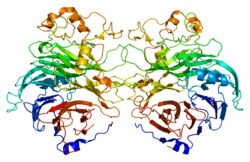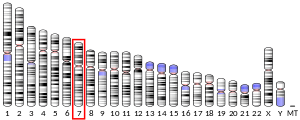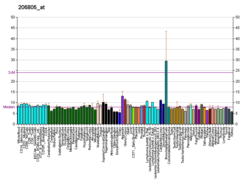SEMA3A
Semaphorin-3A is a protein that in humans is encoded by the SEMA3A gene.[5][6][7]
Function
The SEMA3A gene is a member of the semaphorin family and encodes a protein with an Ig-like C2-type (immunoglobulin-like) domain, a PSI domain and a Sema domain. This secreted Sema3A protein can function as either a chemorepulsive agent, inhibiting axonal outgrowth, or as a chemoattractive agent, stimulating the growth of apical dendrites. In both cases, the protein is vital for normal neuronal pattern development.[7]
Semaphorin-3A is secreted by neurons and surrounding tissue to guide migrating cells and axons in the developing nervous system. Axon pathfinding is the process by which neurons follow very precise paths, sends out axons, and react to specific chemical environments to reach the correct endpoint. The guidance is critical for the precise formation of neurons and the surrounding vasculature. Guidance cues, such as Sema3A, induce the collapse and paralysis of neuronal growth cones during development of the nervous system.
This guidance cue for axons of neurons is signaled through receptor complexes containing Neuropilin-1 (NRP1) and a co-receptor.[8][9][10] One of the first identified intracellular messenger required for the growth cone-collapse induced by Sema3A is the CRMP protein called CRMP2.
In addition to its role in the nervous system, Sema3A also acts as an inhibitor of angiogenesis, the process by which new blood vessels develop.[11]
Clinical significance
The protein Sema3A is highly expressed in scar tissue after traumatic central nervous system injuries, such as spinal cord injury. Sema3A, and the other class 3 semaphorins, contributes to the failure of neuronal regeneration after CNS injury by regulating axonal re-growth, re-myelination, re-vascularisation, and the immune response.[12]
Increased expression of Sema3A is associated with schizophrenia and is seen in a variety of human tumor cell lines. Also, aberrant release of this protein is associated with the progression of Alzheimer's disease.[7][13]
Additionally, the terminal Schwann cells of ALS mice (SOD1 mutant) express Sema3A at fast-fatigable fiber neuromuscular junctions greater than wild-type mice.[14] This expression is greatest pre-symptomatically corresponding to ALS progression in which fast-fatigable fiber denervation precedes clinical symptoms.[15] Because Sema3A is involved in growth cone collapse and axon pruning and repulsion, it potentially holds a causal relationship to synaptic weakening and denervation that precedes motor neuron apoptosis in ALS.[14]
References
- GRCh38: Ensembl release 89: ENSG00000075213 - Ensembl, May 2017
- GRCm38: Ensembl release 89: ENSMUSG00000028883 - Ensembl, May 2017
- "Human PubMed Reference:". National Center for Biotechnology Information, U.S. National Library of Medicine.
- "Mouse PubMed Reference:". National Center for Biotechnology Information, U.S. National Library of Medicine.
- Kolodkin AL, Matthes DJ, Goodman CS (Jan 1994). "The semaphorin genes encode a family of transmembrane and secreted growth cone guidance molecules". Cell. 75 (7): 1389–99. doi:10.1016/0092-8674(93)90625-Z. PMID 8269517.
- Püschel AW, Adams RH, Betz H (Jun 1995). "Murine semaphorin D/collapsin is a member of a diverse gene family and creates domains inhibitory for axonal extension". Neuron. 14 (5): 941–8. doi:10.1016/0896-6273(95)90332-1. PMID 7748561.
- "Entrez Gene: SEMA3A sema domain, immunoglobulin domain (Ig), short basic domain, secreted, (semaphorin) 3A".
- Moret F, Renaudot C, Bozon M, Castellani V (December 2007). "Semaphorin and neuropilin co-expression in motoneurons sets axon sensitivity to environmental semaphorin sources during motor axon pathfinding". Development. 134 (24): 4491–501. doi:10.1242/dev.011452. PMID 18039974.
- Vieira JM, Schwarz Q, Ruhrberg C (May 2007). "Selective requirements for NRP1 ligands during neurovascular patterning". Development. 134 (10): 1833–43. doi:10.1242/dev.002402. PMC 2702678. PMID 17428830.
- Sharma A, Verhaagen J, Harvey AR (2012). "Receptor complexes for each of the Class 3 Semaphorins". Frontiers in Cellular Neuroscience. 6: 28. doi:10.3389/fncel.2012.00028. PMC 3389612. PMID 22783168.
- Maione F, Molla F, Meda C, Latini R, Zentilin L, Giacca M, Seano G, Serini G, Bussolino F, Giraudo E (2009). "Semaphorin 3A is an endogenous angiogenesis inhibitor that blocks tumor growth and normalizes tumor vasculature in transgenic mouse models". The Journal of Clinical Investigation. 119 (11): 3356–72. doi:10.1172/JCI36308. PMC 2769187. PMID 19809158.
- Mecollari, V; Nieuwenhuis, B; Verhaagen, J (2014). "A perspective on the role of class III semaphorin signaling in central nervous system trauma". Frontiers in Cellular Neuroscience. 8: 328. doi:10.3389/fncel.2014.00328. PMC 4209881. PMID 25386118.
- Good PF, Alapat D, Hsu A, Chu C, Perl D, Wen X, Burstein DE, Kohtz DS (November 2004). "A role for semaphorin 3A signaling in degeneration of hippocampal neurons during Alzheimer's disease". J. Neurochem. 91 (3): 716–36. doi:10.1111/j.1471-4159.2004.02766.x. PMID 15485501.
- De Winter F, Vo T, Stam FJ, Wisman LA, Bär PR, Niclou SP, van Muiswinkel FL, Verhaagen J (2006). "The expression of the chemorepellent Semaphorin 3A is selectively induced in terminal Schwann cells of a subset of neuromuscular synapses that display limited anatomical plasticity and enhanced vulnerability in motor neuron disease". Mol. Cell. Neurosci. 32 (1–2): 102–17. doi:10.1016/j.mcn.2006.03.002. PMID 16677822.
- Frey D, Schneider C, Xu L, Borg J, Spooren W, Caroni P (April 2000). "Early and selective loss of neuromuscular synapse subtypes with low sprouting competence in motoneuron diseases". J. Neurosci. 20 (7): 2534–42. doi:10.1523/JNEUROSCI.20-07-02534.2000. PMID 10729333.
Further reading
- Schmidt EF, Strittmatter SM (2007). The CRMP family of proteins and their role in Sema3A signaling. Adv. Exp. Med. Biol. Advances in Experimental Medicine and Biology. 600. pp. 1–11. doi:10.1007/978-0-387-70956-7_1. ISBN 978-0-387-70955-0. PMC 2853248. PMID 17607942.
- Bonaldo MF, Lennon G, Soares MB (1997). "Normalization and subtraction: two approaches to facilitate gene discovery". Genome Res. 6 (9): 791–806. doi:10.1101/gr.6.9.791. PMID 8889548.
- Chen H, Chédotal A, He Z, Goodman CS, Tessier-Lavigne M (1997). "Neuropilin-2, a novel member of the neuropilin family, is a high affinity receptor for the semaphorins Sema E and Sema IV but not Sema III". Neuron. 19 (3): 547–59. doi:10.1016/S0896-6273(00)80371-2. PMID 9331348.
- Takahashi T, Nakamura F, Jin Z, Kalb RG, Strittmatter SM (1999). "Semaphorins A and E act as antagonists of neuropilin-1 and agonists of neuropilin-2 receptors". Nat. Neurosci. 1 (6): 487–93. doi:10.1038/2203. PMID 10196546.
- Takahashi T, Fournier A, Nakamura F, Wang LH, Murakami Y, Kalb RG, Fujisawa H, Strittmatter SM (1999). "Plexin-neuropilin-1 complexes form functional semaphorin-3A receptors". Cell. 99 (1): 59–69. doi:10.1016/S0092-8674(00)80062-8. PMID 10520994.
- Castellani V, De Angelis E, Kenwrick S, Rougon G (2003). "Cis and trans interactions of L1 with neuropilin-1 control axonal responses to semaphorin 3A". EMBO J. 21 (23): 6348–57. doi:10.1093/emboj/cdf645. PMC 136949. PMID 12456642.
- Eastwood SL, Law AJ, Everall IP, Harrison PJ (2003). "The axonal chemorepellant semaphorin 3A is increased in the cerebellum in schizophrenia and may contribute to its synaptic pathology". Mol. Psychiatry. 8 (2): 148–55. doi:10.1038/sj.mp.4001233. PMID 12610647.
- Rieger J, Wick W, Weller M (2003). "Human malignant glioma cells express semaphorins and their receptors, neuropilins and plexins". Glia. 42 (4): 379–89. doi:10.1002/glia.10210. PMID 12730958.
- Serini G, Valdembri D, Zanivan S, Morterra G, Burkhardt C, Caccavari F, Zammataro L, Primo L, Tamagnone L, Logan M, Tessier-Lavigne M, Taniguchi M, Püschel AW, Bussolino F (2003). "Class 3 semaphorins control vascular morphogenesis by inhibiting integrin function". Nature. 424 (6947): 391–7. doi:10.1038/nature01784. PMID 12879061.
- Bachelder RE, Lipscomb EA, Lin X, Wendt MA, Chadborn NH, Eickholt BJ, Mercurio AM (2003). "Competing autocrine pathways involving alternative neuropilin-1 ligands regulate chemotaxis of carcinoma cells". Cancer Res. 63 (17): 5230–3. PMID 14500350.
- Catalano A, Caprari P, Rodilossi S, Betta P, Castellucci M, Casazza A, Tamagnone L, Procopio A (2004). "Cross-talk between vascular endothelial growth factor and semaphorin-3A pathway in the regulation of normal and malignant mesothelial cell proliferation". FASEB J. 18 (2): 358–60. doi:10.1096/fj.03-0513fje. PMID 14656993.
- Bagnard D, Sainturet N, Meyronet D, Perraut M, Miehe M, Roussel G, Aunis D, Belin MF, Thomasset N (2004). "Differential MAP kinases activation during semaphorin3A-induced repulsion or apoptosis of neural progenitor cells". Mol. Cell. Neurosci. 25 (4): 722–31. doi:10.1016/j.mcn.2003.12.007. PMID 15080899.
- Good PF, Alapat D, Hsu A, Chu C, Perl D, Wen X, Burstein DE, Kohtz DS (2005). "A role for semaphorin 3A signaling in the degeneration of hippocampal neurons during Alzheimer's disease". J. Neurochem. 91 (3): 716–36. doi:10.1111/j.1471-4159.2004.02766.x. PMID 15485501.
- Marzioni D, Tamagnone L, Capparuccia L, Marchini C, Amici A, Todros T, Bischof P, Neidhart S, Grenningloh G, Castellucci M (2005). "Restricted innervation of uterus and placenta during pregnancy: evidence for a role of the repelling signal Semaphorin 3A". Dev. Dyn. 231 (4): 839–48. doi:10.1002/dvdy.20178. PMID 15517571.
- Gu C, Yoshida Y, Livet J, Reimert DV, Mann F, Merte J, Henderson CE, Jessell TM, Kolodkin AL, Ginty DD (2005). "Semaphorin 3E and plexin-D1 control vascular pattern independently of neuropilins". Science. 307 (5707): 265–8. doi:10.1126/science.1105416. PMID 15550623.
- Kashiwagi H, Shiraga M, Kato H, Kamae T, Yamamoto N, Tadokoro S, Kurata Y, Tomiyama Y, Kanakura Y (2005). "Negative regulation of platelet function by a secreted cell repulsive protein, semaphorin 3A". Blood. 106 (3): 913–21. doi:10.1182/blood-2004-10-4092. PMID 15831706.
- Tannemaat MR, Korecka J, Ehlert EM, Mason MR, van Duinen SG, Boer GJ, Malessy MJ, Verhaagen J (2007). "Human neuroma contains increased levels of semaphorin 3A, which surrounds nerve fibers and reduces neurite extension in vitro". J. Neurosci. 27 (52): 14260–4. doi:10.1523/JNEUROSCI.4571-07.2007. PMID 18160633.
External links
- SEMA3A human gene location in the UCSC Genome Browser.
- SEMA3A human gene details in the UCSC Genome Browser.
- Overview of all the structural information available in the PDB for UniProt: O08665 (Mouse Semaphorin-3A) at the PDBe-KB.






